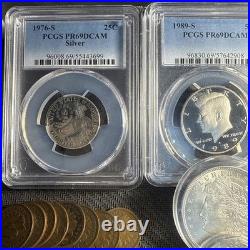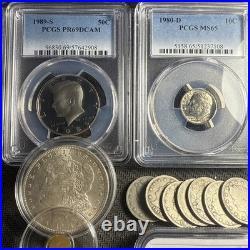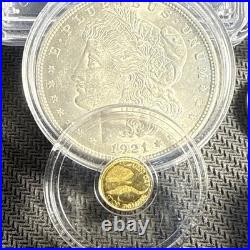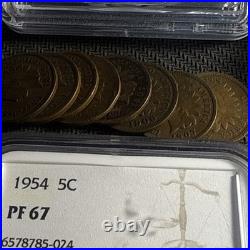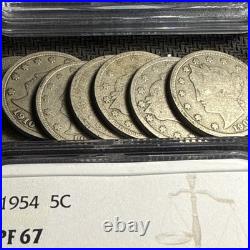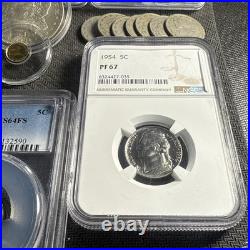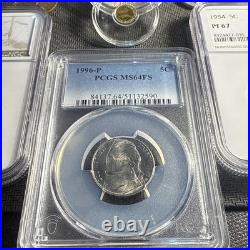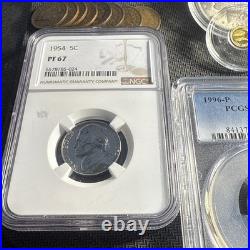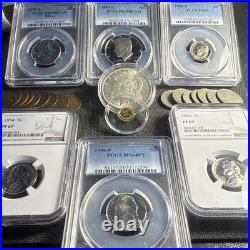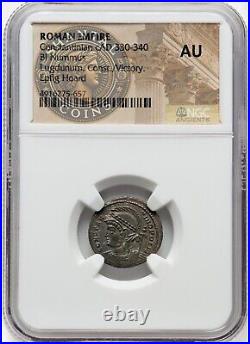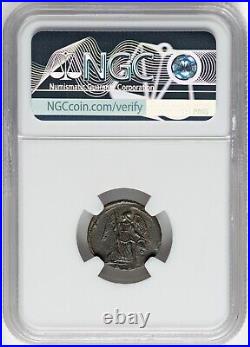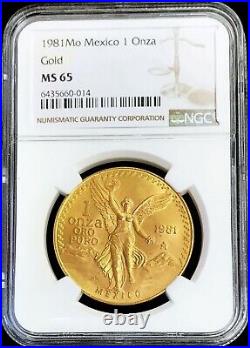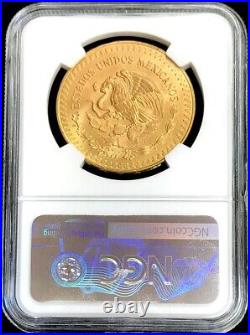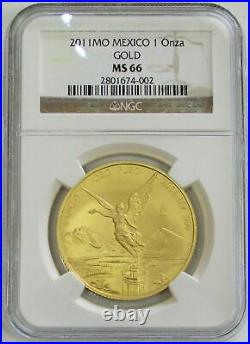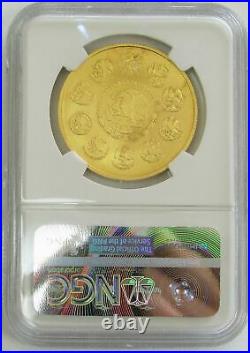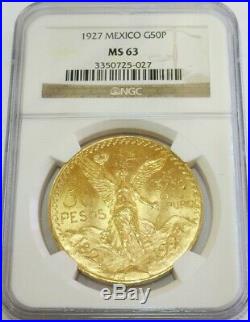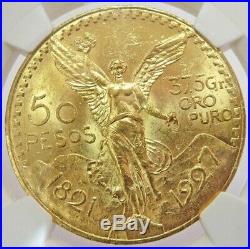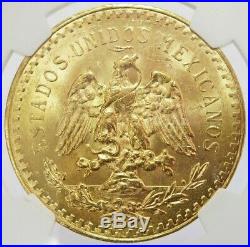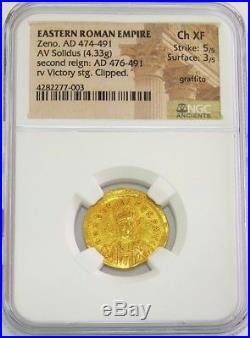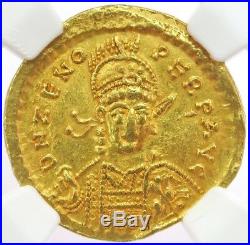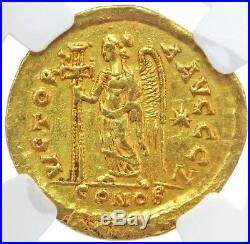
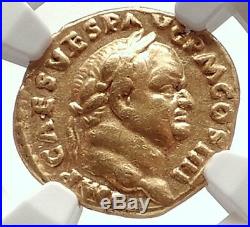
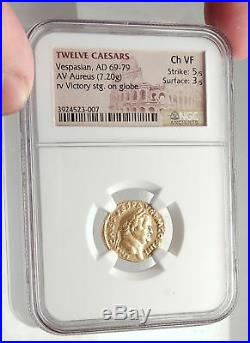
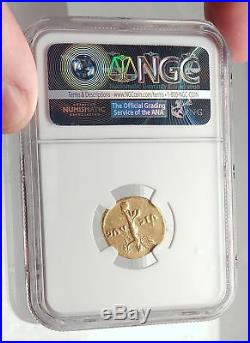
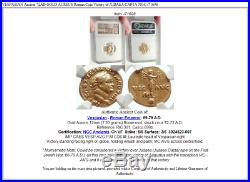

Item: i71698 Authentic Ancient Coin of. Gold Aureus 17mm (7.20 grams) Rome mint, struck circa 72-73 A. Reference: RIC 361; Calico 699b Certification: NGC Ancients. Ch VF Strike: 5/5 Surface: 3/5 3924523-007. IMP CAES VESP AVG P M COS IIII, Laureate head of Vespasian right. Victory standing facing right on globe, holding wreath and palm; VIC-AVG across central field. Numismatic Note: Could be considered a Victory over Judaea (Judaea Capta) type in the First Jewish War, 66-70 A. , as this coin celebrates the victory of Augustus with the inscription VIC-AVG and it would be a likely reference to that victory. The first Jewish-Roman War (66-70), sometimes called The Great Revolt (Hebrew: , ha-Mered Ha-Gadol), was the first of three major rebellions by the Jews of the Iudaea Province (Judea Province), against the Roman Empire (the second was the Kitos War in 115-117 CE; the third was Bar Kokhba’s revolt, 132-135)CE. It began in the year 66 initially because of Greek and Jewish religious tensions but grew with anti-taxation protests and attacks upon Roman citizens. It ended when legions under Titus besieged and destroyed the centre of rebel resistance in Jerusalem, and defeated the remaining Jewish strongholds. Sole Reign with Titus. As Caesars 71-79 A. Sole Reign (with Titus as Imperator and Domitian as Caesar). Titus Flavius Vespasianus , known in English as Vespasian (November 17 9AD – June 23 79AD), was a Roman Emperor who reigned from 69 AD until his death in 79 AD. Vespasian was the founder of the short-lived Flavian dynasty, which ruled the Roman Empire between 69 AD and 96 AD He was succeeded by his sons Titus (79-81) and Domitian (81-96). Vespasian descended from a family of equestrians which rose into the senatorial rank under the emperors of the Julio-Claudian dynasty. Although he attained the standard succession of public offices, holding the consulship in 51, Vespasian became more reputed as a successful military commander, partaking in the Roman invasion of Britain in 43, and subjugating the Judaea province during the Jewish rebellion of 66. While Vespasian was preparing to besiege the city of Jerusalem during the latter campaign, emperor Nero committed suicide, plunging the Roman Empire into a year of civil war known as the Year of the Four Emperors. After Galba and Otho perished in quick succession, Vitellius became emperor in mid 69. In response, the armies in Egypt and Judaea themselves declared Vespasian emperor on July 1. On December 20, Vitellius was defeated, and the following day, Vespasian was declared emperor by the Roman Senate. Little factual information survives about Vespasian’s government during the ten years he was emperor. His reign is best known for financial reforms following the demise of the Julio-Claudian dynasty, the successful campaign against Judaea, and several ambitious construction projects such as the Colosseum. Upon his death on June 23, 79, he was succeeded by his eldest son Titus. Family and early career. Vespasian was born in Falacrina, in the Sabine country near Reate. His mother, Vespasia Polla, was the sister of a Senator. After prompting from his mother, Vespasian followed his older brother, also called Titus Flavius Sabinus, into public life. He served in the army as a military tribune in Thrace in 36. The following year he was elected quaestor and served in Crete and Cyrene. He rose through the ranks of Roman public office, being elected aedile on his second attempt in 39 and praetor on his first attempt in 40, taking the opportunity to ingratiate himself with the Emperor Caligula. In the meantime, he married Domitilla the Elder, the daughter of an equestrian from Ferentium. They had two sons, Titus Flavius Vespasianus b. 41 and Titus Flavius Domitianus b. 51, and a daughter, Domitilla b. Domitilla died before Vespasian became emperor. Thereafter his mistress, Caenis, was his wife in all but name until she died in 74. Upon the accession of Claudius as emperor in 41, Vespasian was appointed legate of Legio II Augusta , stationed in Germania, thanks to the influence of the Imperial freedman Narcissus. In 43, Vespasian and the II Augusta participated in the Roman invasion of Britain, and he distinguished himself under the overall command of Aulus Plautius. After participating in crucial early battles on the rivers Medway and Thames, he was sent to reduce the south west, penetrating through the modern counties of Hampshire, Wiltshire, Dorset, Somerset, Devon and Cornwall with the probable objectives of securing the south coast ports and harbours along with the tin mines of Cornwall and the silver and lead mines of Somerset. Vespasian marched from Noviomagus Reginorum (Chichester) to subdue the hostile Durotriges and Dumnonii tribes. Captured twenty oppida (towns, or more probably hill forts, including Hod Hill and Maiden Castle in Dorset). He also invaded Vectis (the Isle of Wight), finally setting up a fortress and legionary headquarters at Isca Dumnoniorum (Exeter). These successes earned him triumphal regalia (ornamenta triumphalia) on his return to Rome. Vespasian was elected consul for the last two months of 51, after which he withdrew from public life. He came out of retirement in 63 when he was sent as governor to Africa Province. According to Tacitus ii. 97, his rule was “infamous and odious” but according to Suetonius Vesp. 4, he was “upright and, highly honourable”. On one occasion he was pelted with turnips. Vespasian used his time in North Africa wisely. Corruption was so rife, that it was almost expected that a governor would come back from these appointments with his pockets full. During his time in North Africa, he found himself in financial difficulties and was forced to mortgage his estates to his brother. To revive his fortunes he turned to the mule trade and gained the nickname mulio (mule-driver). Returning from Africa, Vespasian toured Greece in Nero’s retinue, but lost Imperial favour after paying insufficient attention (some sources suggest he fell asleep) during one of the Emperor’s recitals on the lyre, and found himself in the political wilderness. However, in 66, Vespasian was appointed to conduct the war in Judea. A revolt there had killed the previous governor and routed Licinius Mucianus, the governor of Syria, when he tried to restore order. Two legions, with eight cavalry squadrons and 10 auxiliary cohorts, were therefore dispatched under the command of Vespasian to add to the one already there. His elder son, Titus, served on his staff. During this time he became the patron of Flavius Josephus, a Jewish resistance leader turned Roman agent who would go on to write his people’s history in Greek. In the end, thousands of Jews were killed and many towns destroyed by the Romans, who successfully re-established control over Judea. They took Jerusalem in 70. He is remembered by Jews as a fair and humane official, in contrast to the notorious Herod the Great. Josephus wrote that after the Roman Legio X Fretensis accompanied by Vespasian destroyed Jericho on June 21, 68, he took a group of Jews who could not swim (possibly Essenes from Qumran), fettered them, and threw them into the Dead Sea to test its legendary buoyancy. Sure enough, the Jews shot back up after being thrown in from boats and floated calmly on top of the sea. Year of Four Emperors. Main article: Year of the Four Emperors. Map of the Roman Empire during the Year of the Four Emperors (69 AD). Blue areas indicate provinces loyal to Vespasian and Gaius Licinius Mucianus. After the death of Nero in 68, Rome saw a succession of short-lived emperors and a year of civil wars. Galba was murdered by Otho, who was defeated by Vitellius. Otho’s supporters, looking for another candidate to support, settled on Vespasian. According to Suetonius, a prophecy ubiquitous in the Eastern provinces claimed that from Judaea would come the future rulers of the world. Vespasian eventually believed that this prophecy applied to him, and found a number of omens, oracles, and portents that reinforced this belief. He also found encouragement in Mucianus, the governor of Syria; and, although Vespasian was a strict disciplinarian and reformer of abuses, Vespasian’s soldiers were thoroughly devoted to him. All eyes in the East were now upon him. Mucianus and the Syrian legions were eager to support him. While he was at Caesarea, he was proclaimed emperor (July 1, 69), first by the army in Egypt under Tiberius Julius Alexander, and then by his troops in Judaea (July 11 according to Suetonius, July 3 according to Tacitus). Nevertheless, Vitellius, the occupant of the throne, had Rome’s best troops on his side – the veteran legions of Gaul and the Rhineland. But the feeling in Vespasian’s favour quickly gathered strength, and the armies of Moesia, Pannonia, and Illyricum soon declared for him, and made him the de facto master of half of the Roman world. While Vespasian himself was in Egypt securing its grain supply, his troops entered Italy from the northeast under the leadership of M. They defeated Vitellius’s army (which had awaited him in Mevania) at Bedriacum (or Betriacum), sacked Cremona and advanced on Rome. They entered Rome after furious fighting. In the resulting confusion, the Capitol was destroyed by fire and Vespasian’s brother Sabinus was killed by a mob. On receiving the tidings of his rival’s defeat and death at Alexandria, the new emperor at once forwarded supplies of urgently needed grain to Rome, along with an edict or a declaration of policy, in which he gave assurance of an entire reversal of the laws of Nero, especially those relating to treason. While in Egypt he visited the Temple of Serapis, where reportedly he experienced a vision. Later he was confronted by two labourers who were convinced that he possessed a divine power that could work miracles. Aftermath of the civil war. Bust of Vespasian, Pushkin Museum, Moscow. Vespasian was declared emperor by the Senate while he was in Egypt in December of 69 (the Egyptians had declared him emperor in June of 69). In the short-term, administration of the empire was given to Mucianus who was aided by Vespasian’s son, Domitian. By his own example of simplicity of life – he caused something of a scandal when it was made known he took his own boots off – he initiated a marked improvement in the general tone of society in many respects. In early 70, Vespasian was still in Egypt, the source of Rome’s grain supply, and had not yet left for Rome. According to Tacitus, his trip was delayed due to bad weather. Modern historians theorize that Vespasian had been and was continuing to consolidate support from the Egyptians before departing. Stories of a divine Vespasian healing people circulated in Egypt. In addition to the uprising in Egypt, unrest and civil war continued in the rest of the empire in 70. In Judea, rebellion had continued from 66. Vespasian’s son, Titus, finally subdued the rebellion with the capture of Jerusalem and destruction of the Jewish Temple in 70. According to Eusebius, Vespasian then ordered all descendants of the royal line of David to be hunted down, causing the Jews to be persecuted from province to province. Several modern historians have suggested that Vespasian, already having been told by Josephus that he was prophesied to become emperor whilst in Judaea, was probably reacting to other widely-known Messianic prophecies circulating at the time, to suppress any rival claimants arising from that dynasty. In January of the same year, an uprising occurred in Gaul and Germany, known as the second Batavian Rebellion. This rebellion was headed by Gaius Julius Civilis and Julius Sabinus. Sabinus, claiming he was descended from Julius Caesar, declared himself emperor of Gaul. The rebellion defeated and absorbed two Roman legions before it was suppressed by Vespasian’s brother-in-law, Quintus Petillius Cerialis, by the end of 70. Arrival in Rome and gathering support. In mid-70, Vespasian first came to Rome. Vespasian immediately embarked on a series of efforts to stay in power and prevent future revolts. He offered gifts to many in the military and much of the public. Soldiers loyal to Vitellius were dismissed or punished. He also restructured the Senatorial and Equestrian orders, removing his enemies and adding his allies. Regional autonomy of Greek provinces was repealed. Additionally, he made significant attempts to control public perception of his rule. Many modern historians note the increased amount of propaganda that appeared during Vespasian’s reign. Stories of a supernatural emperor who was destined to rule circulated in the empire. Nearly one-third of all coins minted in Rome under Vespasian celebrated military victory or peace. The word vindex was removed from coins so as not to remind the public of rebellious Vindex. Construction projects bore inscriptions praising Vespasian and condemning previous emperors. A temple of peace was constructed in the forum as well. Vespasian approved histories written under his reign, ensuring biases against him were removed. Vespasian also gave financial rewards to ancient writers. The ancient historians who lived through the period such as Tacitus, Suetonius, Josephus and Pliny the Elder speak suspiciously well of Vespasian while condemning the emperors who came before him. Tacitus admits that his status was elevated by Vespasian, Josephus identifies Vespasian as a patron and savior, and Pliny dedicated his Natural Histories to Vespasian, Titus. Those who spoke against Vespasian were punished. A number of stoic philosophers were accused of corrupting students with inappropriate teachings and were expelled from Rome. Helvidius Priscus, a pro-republic philosopher, was executed for his teachings. Construction of the Flavian Amphitheatre, better known as the Colosseum, was begun by Vespasian, and ultimately finished by his son Titus. Between 71 and 79, much of Vespasian’s reign is a mystery. Historians report that Vespasian ordered the construction of several buildings in Rome. Additionally, he survived several conspiracies against him. Vespasian helped rebuild Rome after the civil war. He added the temple of Peace and the temple to the Deified Claudius. In 75, he erected a colossal statue of Apollo, begun under Nero, and he dedicated a stage of the theater of Marcellus. He also began construction of the Colosseum. Suetonius claims that Vespasian was met with “constant conspiracies” against him. Only one conspiracy is known specifically, though. In 78 or 79, Eprius Marcellus and Aulus Caecina Alienus attempted to kill Vespasian. Why these men turned against Vespasian is not known. Military pursuits and death. In 78, Agricola was sent to Britain, and both extended and consolidated the Roman dominion in that province, pushing his way into what is now Scotland. On June 23 of the following year, Vespasian was on his deathbed and expiring rapidly, he demanded that he be helped to stand as he believed “An emperor should die on his feet”. He died of an intestinal inflammation which led to excessive diarrhea. His purported great wit can be glimpsed from his last words; Væ, puto deus fio , Damn. Vespasian was known for his wit and his amiable manner alongside his commanding persona and military prowess. He could be liberal to impoverished Senators and equestrians and to cities and towns desolated by natural calamity. He was especially generous to men of letters and rhetors, several of whom he pensioned with salaries of as much as 1,000 gold pieces a year. Quintilian is said to have been the first public teacher who enjoyed this imperial favor. Pliny the Elder’s work, the Natural History , was written during Vespasian’s reign, and dedicated to Vespasian’s son Titus. Vespasian distrusted philosophers in general, viewing them as unmanly complainers who talked too much. It was the idle talk of philosophers, who liked to glorify the good times of the Republic, that provoked Vespasian into reviving the obsolete penal laws against this profession as a precautionary measure. Only one however, Helvidius Priscus, was put to death, and he had repeatedly affronted the Emperor by studied insults which Vespasian had initially tried to ignore, “I will not kill a dog that barks at me, ” were his words on discovering Priscus’s public slander. Vespasian was indeed noted for mildness when dealing with political opposition. According to Suetonius, he bore the frank language of his friends, the quips of pleaders, and the impudence of the philosophers with the greatest patience. Marcus Didius Falco novels. The Course of Honour , a novel by Lindsey Davis. Edward Rutherfurd’s historical fiction novel Sarum contains an account of one the protagonists’ (a Celtic chief) meeting Vespasian during his campaign through southern Britannia. Vespasian, as legate under Aulus Plautius, is a regular secondary character in Simon Scarrow’s Eaglegle series. World-renowned expert numismatist, enthusiast, author and dealer in authentic ancient Greek, ancient Roman, ancient Byzantine, world coins & more. Ilya Zlobin is an independent individual who has a passion for coin collecting, research and understanding the importance of the historical context and significance all coins and objects represent. Send me a message about this and I can update your invoice should you want this method. Getting your order to you, quickly and securely is a top priority and is taken seriously here. Great care is taken in packaging and mailing every item securely and quickly. What is a certificate of authenticity and what guarantees do you give that the item is authentic? You will be very happy with what you get with the COA; a professional presentation of the coin, with all of the relevant information and a picture of the coin you saw in the listing. Additionally, the coin is inside it’s own protective coin flip (holder), with a 2×2 inch description of the coin matching the individual number on the COA. Whether your goal is to collect or give the item as a gift, coins presented like this could be more prized and valued higher than items that were not given such care and attention to. When should I leave feedback? Please don’t leave any negative feedbacks, as it happens sometimes that people rush to leave feedback before letting sufficient time for their order to arrive. The matter of fact is that any issues can be resolved, as reputation is most important to me. My goal is to provide superior products and quality of service. How and where do I learn more about collecting ancient coins? Visit the “Guide on How to Use My Store”. For on an overview about using my store, with additional information and links to all other parts of my store which may include educational information on topics you are looking for. The item “VESPASIAN Ancient 72AD GOLD AUREUS Roman Coin Victory of JUDAEA CAPTA NGC i71698″ is in sale since Sunday, August 19, 2018. This item is in the category “Coins & Paper Money\Coins\ Ancient\Roman\ Imperial (27 BC-476 AD)”. The seller is “highrating_lowprice” and is located in Rego Park, New York. This item can be shipped worldwide.
- Certification Number: 3924523-007
- Certification: NGC
- Grade: Ch VF
- Composition: Gold
- Ruler: Vespasian
- Denomination: Solidus


